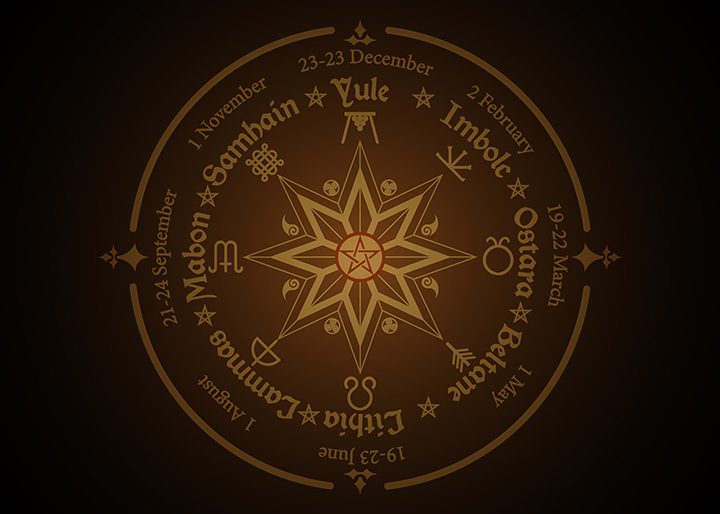|
Today, the 21st of December, is the Winter Solstice, unless you happen to be in sub-Saharan Africa, Australia, Argentina, or Antarctica, or other points south of the equator. In that case, today is the first day of summer, the Summer Solstice, the time when the sun is closest to the Tropic of Capricorn and farthest from the Tropic of Cancer. Ironically, it is also the period when the Earth is at its perihelion, the closest it will be to the Sun all year. This is good for the Northern Hemisphere, as it means that our summers (when the Earth is at aphelion – the farthest point from the Sun) are relatively mild, as are our winters. The actual orbit of Earth around the Sun is pretty close to circular – the major axis of the ellipse is about 1.02 astronomical units, while the minor axis is about 0.98 AUs, but that difference (about 4.1%) makes a difference of about 1.5 ℃ on average between perigee and apogee – summers are hotter in the south, winters are colder. Of course, this is also moderated somewhat by the fact that the southern hemisphere has far more water (81/19%) than land, compared to the northern hemisphere’s 61/39%. This means that the southern oceans receive more of the heat of the Sun than the northern ones do. The amount of heat stored across the southern Pacific and Indian Oceans oscillates in patterns. When the Eastern Pacific (off the coast of South America) holds the most latent heat around the solstice, this pattern is given the name El Nino, for the Christ Child. On the other hand, when the heat has migrated to the Western Pacific ocean and into the Indian Ocean, this becomes La Nina. This year, we are definitely in a La Nina pattern, making for a Jet Stream pattern that moves literally several rivers worth of water into the sky from the East China Sea all the way to the Pacific Northwest, giving the latter’s traditional unending rains. In the Northern Hemisphere, days are at their shortest during the Winter Solstice. This has to do with the 23-degree tilt in the Earth’s rotational axis relative to the sun. It is likely that this tilt came from the collision of the proto-Earth around 4.3 million years ago with a planet called Theia, likely almost dead center to the proto-Earth (Gaia). The resulting impact caused the only partially solid crust of the Earth to reheat (resulting in the creation of crustal metamorphic rock) with the core of Theia slamming into the Earth before cracking the crust on the other side and ejecting molten magma, that for a while, gave Earth rings similar to those that Saturn has now. Over the course of the next hundred million years, those rings coalesced into Luna (the Moon), while the resulting angular momentum introduced a wobble in Earth’s orbit that causes the planet to precess like a top every 26,000 years or so. This precession means that in roughly 13,000 years, the North Star, currently Polaris (in Ursa Minor), will instead be the gas giant Vega, about 2 ½ times the size of our Sun. In Biblical narrative, three wise men (Magi) followed a star to Bethlehem to bear gifts to the Christ Child. While Polaris is one suggestion, others that have been proposed include Halley’s Comet (in 23 BC), as well as potentially a supernova around 6 BC that would likely have been visible for weeks. It’s worth noting that the word Magus itself comes from the Babylonian, and was the name adopted in both Hebrew and Phoenician (which were very similar) for astronomers, rather than kings. The Phoenicians managed to spread one of the earliest calendars more than four thousand years ago via their broad naval shipping system. This calendar was largely seasonal in nature and was broken up into eight cardinal and semi-cardinal directions (octants) that would become familiar to mariners everywhere as the compass rose. The Winter Solstice at that point became known as Yule (especially in the North, thanks to the Danube-traveling Vikings. The solstices (suntimes) and equinoxes (equal nights) marked the path of the sun, with the off-octants then forming the mid-seasonal midpoints. This would hold sway well into the rise of the Roman calendar, which was based upon the lunar cycle, and the Graeco-Phoenician sextant, which was used to measure star positions at night, also ended up reflecting the change in calendar thinking even after 450 AD, when the Roman Empire “fell” (more accurate, moved to Byzantium). By the way, the use of the term AD (Anno Domini, or in the year of the lord) didn’t come about until the 5th century AD by Dionysius Exiguus, a churchman of Scythia, who was attempting to determine what the proper date for Easter should be. It was nearly four hundred years later before 1 AD was established as the beginning of the Christian era. Up until that point, even the Church reckoned time primarily based upon a calendar commemorating the founding of Rome as of April 21, 753 BC (the precision of which came several centuries later). This means that had the Italian church in the 9th century not made the decision to adopt the new calendar, this year would be 2874 Anno Imperii Romani, and we would now be gearing up to celebrate Saturnalia. While on the topic of calendars, the last four months of the modern calendar are September, October, November, and December. If you’re familiar with Romance languages, Septem, Octum, Novem, and Decem are the Latin forms for seven through ten. Yet December is the 12th month. The discrepancy comes from the fact that the original Calendar of Romulus only had ten months of 36 days, starting in March, which probably originally had a name something like Unum (one). As Rome grew, various gods’ priests laid claim to various months, with Mars (Martis or March), Avril (the Roman name for Spring) becoming April, the Goddess Maia becoming May, and the Goddess Juno becoming June. In 453 BC, the Roman calendar was reformed to add two more months – January, after the God Janus, keeper of doors, and February, which meant the Cold month, making each of the now twelve months have 30 days. When Julius Caesar became the Emperor of Rome he decided to claim the fifth (now seventh) month, Quintilis, and made it Julii. His successor, Augustus Caesar did the same thing with the sixth (now eighth) month, Sextillia, calling it Augustii. This became the Julian Calendar, and it held sway for nearly sixteen hundred years. The Julian calendar went through one major revision. The Earth revolves on its axis every 24 hours, but the circuit of the Earth around the sun takes 365.25 days. The Romans, who were very good at this, took the quarter day into account by creating a leap day every four years. However, this made the Julian calendar a little too long (by about 11 minutes), which meant that over the course of 1600 years, Easter was beginning to creep slowly into April, rather than on the Spring Equinox of March 21. Pope Gregory XIII followed the recommendation of Italian astronomer Aloysus Lilius to not remove the leap day every century that was divisible by 400, which was well-received by everyone, then to move the calendar forward by ten days, which was not. Indeed, this missing ten days caused a great deal of turmoil, as people believed that those days had been stolen from them by the church, and may have been one of the factors to usher in the Renaissance in reaction to this high-handed move. Protestant countries, in particular, saw this as some kind of deep Catholic conspiracy, and most of the Northern countries did not adopt it until the early 17th century. England didn’t adopt the Gregorian Calendar until 1752 (which was about the same time that it was adopted in the United States). Ben Franklin notably quipped about this that “It is pleasant for an old man to be able to go to bed on September 2, and not have to get up until September 14.” So, whatever day it is, and whatever your plans for the holidays, keep in mind that there’s always a useful story behind the data and that sometimes the reason we work with data the way that we do has less to do with utility and more to do with vanity. In Media Res, Kurt Cagle To subscribe to the DSC Newsletter, go to Data Science Central and become a member today. It’s free!
Data Science Central Editorial CalendarDSC is looking for editorial content specifically in these areas for January, with these topics having higher priority than other incoming articles.
DSC Featured Articles
Picture of the Week
|






 5 modes of analytics
5 modes of analytics